Get jjigae with it: Where to get 4 great Korean soups and stews in Orange County
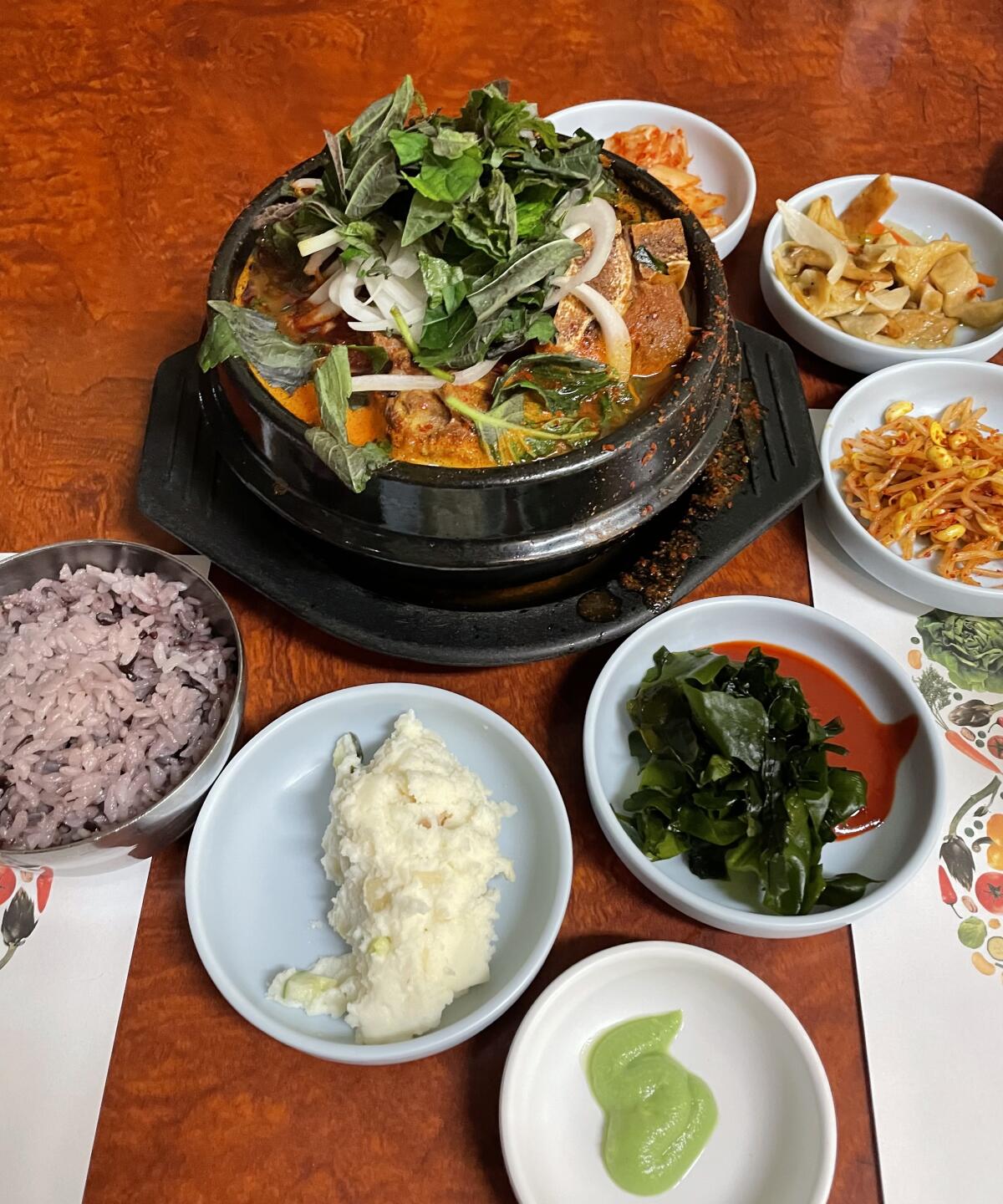
- Share via
I would argue that no other culture on Earth has as many hearty, spicy, full-bodied soups and stews than Korea. There are as many soups and stews in Korean cuisine as there are pastas in Italy.
Most are winter weather food, curative elixirs for stuffy noses and scratchy throats. But at their core, these dishes are always comforting, always satisfying, but usually with a little more kick than mom’s chicken noodle.
Here is just a sampling of two soups (called “tang”) and two stews (called “jjigae”) and where to get them in Orange County.
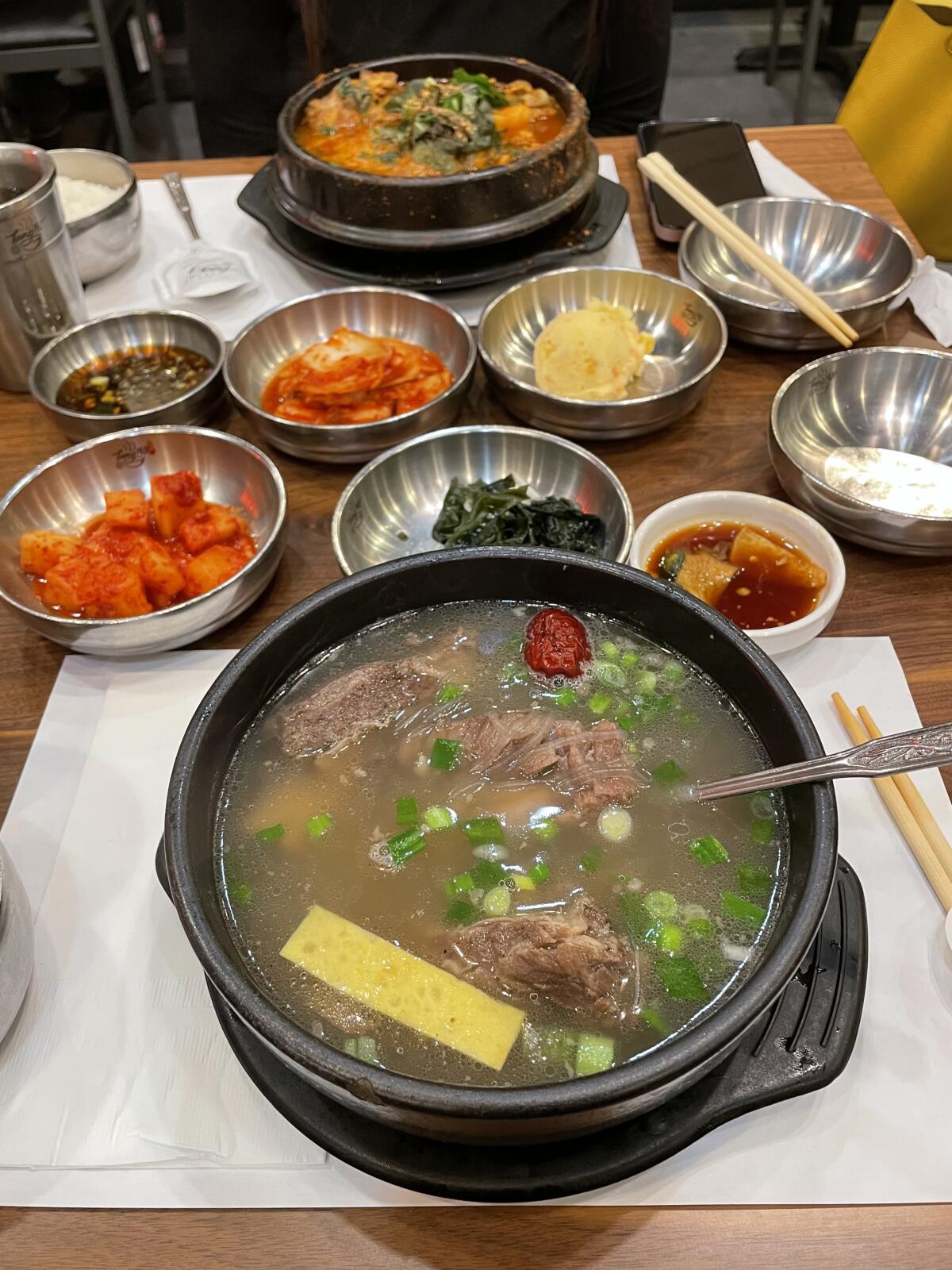
Galbi-tang
What is it? Your first virgin slurp of galbi-tang will be revelatory. It will be like when you tasted real ramen for the first time. You’ll ask yourself, “Where have you been all my life?”
You may recognize the word “galbi” in the name, though. It’s from the same part of the cow as those barbecued short ribs piled high on your last Hawaiian plate lunch. But in galbi-tang, they’re cut to 2-inch pieces. These are actual ribs — bones outweighing flesh. Since they’re slow-cooked in the broth, you can peel off the meat with just a gentle tug of your chopsticks. It is, however, not inappropriate to grab a rib with your hand and tear off mouthfuls with your teeth. But dab on the mustard-smeared soy sauce first. You need it to cut through the richness.
Then move on to the crystal-clear broth. Green onions, cloves of garlic, thinly sliced omelet, vermicelli noodles and dots of red jujubes garnish a dish that is the least spicy on this list. But that’s not to say it isn’t flavor packed. This soup is simultaneously nectar-sweet, salty and savory. Simple and comforting, it hides the fact that it takes experience and saintly patience to make something this good.
Where to get it? Tang 190, 14121 Jeffrey Road, Irvine.
The name of the restaurant, Tang 190, means two things: “Tang” is “soup” and “190” is the temperature in Celsius at which an ideal pot is served. And though Tang 190 is dedicated to all things Korean soup — everything from a pork and potato to a whole chicken with ginseng — it’s the galbi-tang you want. Look for it listed as “beef back rib soup.”
At Tang 190, every soup is accompanied with all the hot buckwheat tea you can drink and four basic but essential banchan (Korean side dishes) that are infinitely refillable. The array includes obligatory kimchi, but more importantly an addictive canary-yellow potato salad that yet again proves no one does a better potato salad than Koreans.
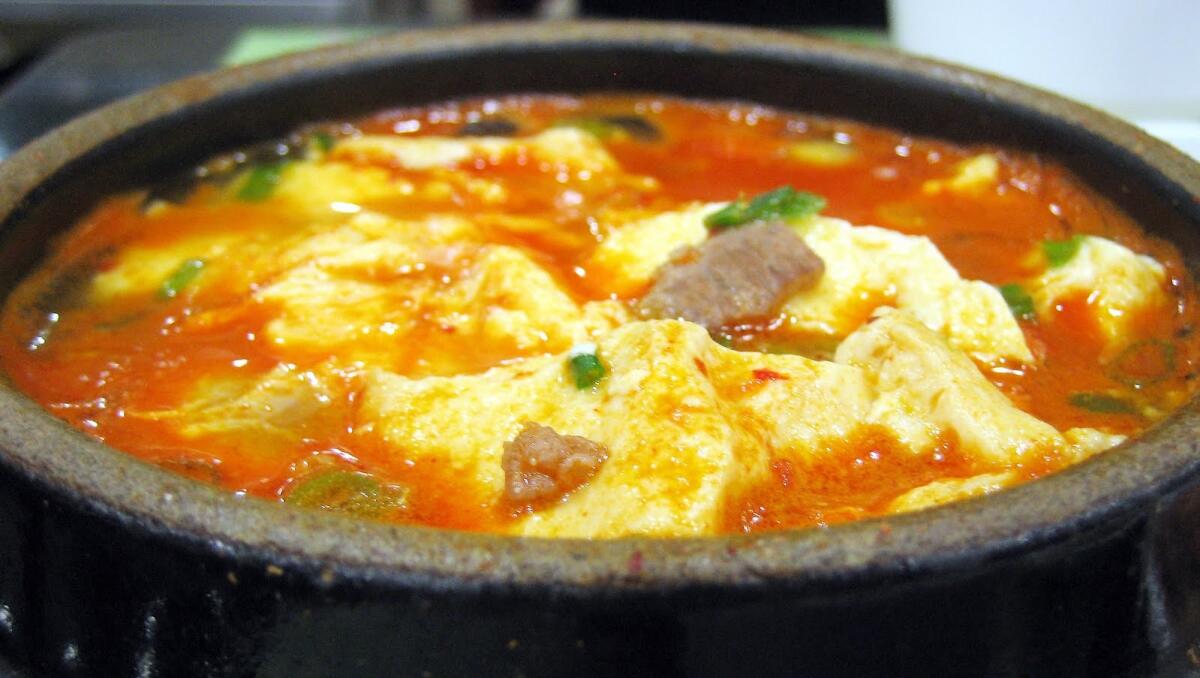
Sundubu-jjigae
What is it? Though sundubu-jjigae eats like a soup, it’s technically a stew, so you won’t find it in restaurants that only specialize in soup. To get sundubu-jjigae, you need to go to a sundubu-jjigae restaurant.
Served out of a thick, cast-iron pot in which it was simmered, sundubu-jjigae involves a savory broth, silken tofu and proteins of your choice. Since it’s meant to be customizable, you can’t order sundubu-jjigae without being asked what spice level you want.
“White” is mildest. Beyond that, the levels can go up to a chili-spiked hell broth that sputters like an angered volcano god.
Regardless of the spice level, the first order of business is to crack a raw egg into the roiling brew. Bury it near the bottom so that it poaches beneath the curds.
Then scoop out spoonful after quivering spoonful of the soft tofu and let it slide down your gullet. Sip the broth, fish out a piece of meat or seafood, then chase it with some rice. Cool off with banchan such as a delicately fried yellow croaker fish, sesame-oil marinated bean sprouts, potato salad and kimchi — all required accompaniments to this Korean stew of stews.
Where to get it? BCD Tofu House, 2700 Alton Pkwy. #135, Irvine; 9520 Garden Grove Blvd. #9, Garden Grove; 5321 Beach Blvd., Buena Park.
BCD is part of a chain that has locations in four states. There are three in O.C., but of those only the Irvine and Garden Grove restaurants boast a 2 a.m. closing time. Though there is some variability in execution between restaurants in the chain, when it’s after midnight and it’s freezing, any gripes melt away when the stew’s steamy fumes waft up to warm your face and the free-flowing plates of banchan never stop.
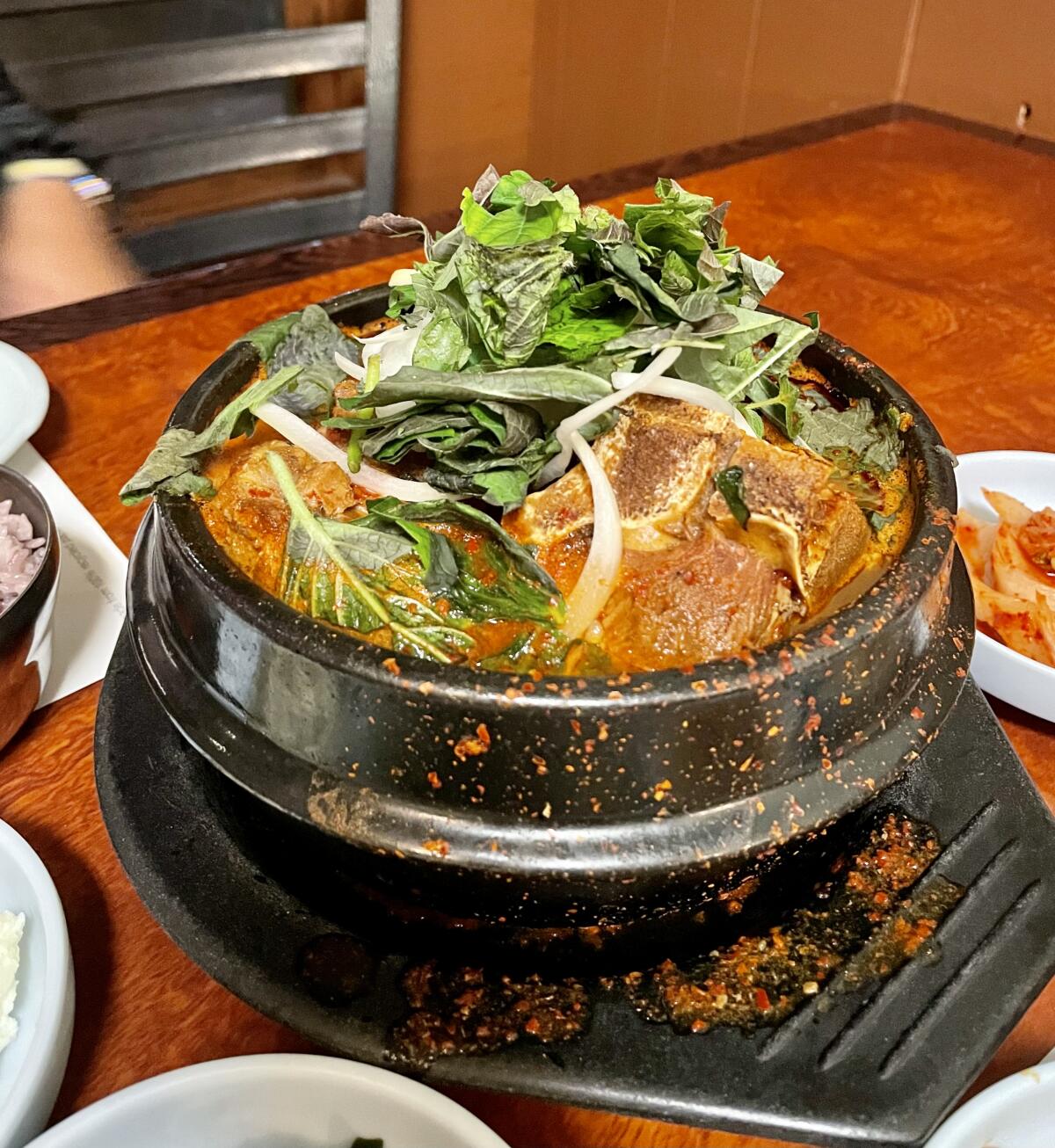
Gamja-tang
What is it? If you were a whiz at the children’s board game Operation, you’ll love gamja-tang. It’s a soup that requires patience and manual dexterity. You’ll use your chopsticks like surgical tweezers to extract the soft, soft meat from the nook and crannies of the soup’s main ingredient: pork spine.
It’s a treasure hunt that will yield dividends of the most succulent pork that isn’t barbecue. If you’re squeamish on the prospect of dealing with pig vertebrae, know that typical instructions for preparing the dish include meticulously rinsing the pieces, then pre-boiling them to drive out impurities.
When the bones are finally simmered in the soup, it’s for hours — long enough to get the meat to a fork-tender state. The process also melts all the collagen into the broth, creating a lip-smacking soup that’s then flavored with garlic, Korean pepper powder and pepper paste.
Potatoes, perilla leaves and cabbage complete the meal — a soul-warming soup that takes a little work to eat but is perfect with a bowl of hot rice.
Where to get it? Gamjatang House, 9567 Garden Grove Blvd., Garden Grove; 5232 Beach Blvd., Buena Park.
Like other Korean soup purveyors, Gamjatang House, which has two branches in Orange County, doesn’t just serve gamja-tang, but you’d be missing the point if you didn’t order it.
The restaurant is gloriously no frills. Its square footage is small enough that the smell of simmering gamja-tang routinely escapes the kitchen and fills the dining room. Though most customers order one gamja-tang per person, one portion easily feeds two.
But as formidable as a serving already is, it comes with Korean purple rice and five refillable banchan dishes, including a fishcake stir fry that’s good enough to be its own meal.
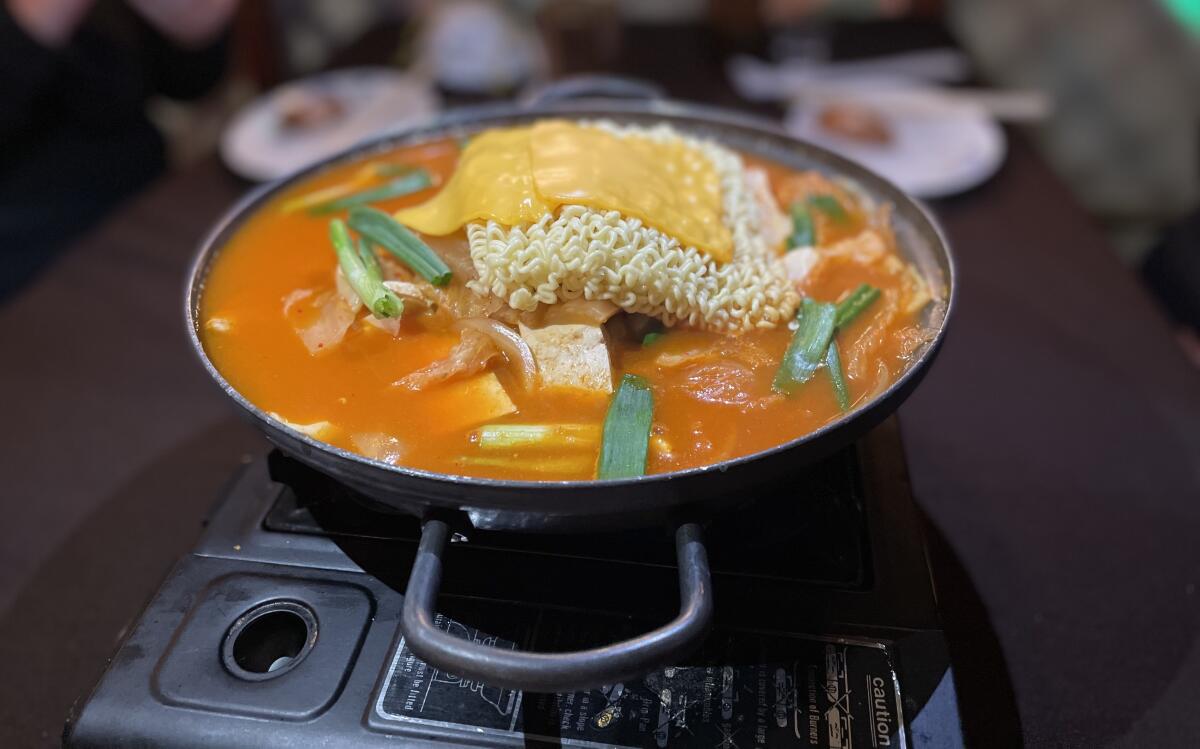
Budae-jjigae
What is it? Budae–jjigae, or “army base stew,” can be traced back to a town called Uijeongbu, which found itself in need of supplies when food was scarce during the war. They created the dish out of necessity from whatever they could get from the American army base nearby, which included SPAM and other processed meats.
But just as SPAM musubi evolved to be a Hawaiian staple, budae-jjigae also became part of modern Korean cuisine. If you go to Uijeongbu now, you’ll smell the wafting scent of kimchi and hot dogs mixing in the air as many restaurants now pride themselves in serving the dish.
The base broth is always a spicy, brick-red soup flavored with red pepper flakes and red pepper paste, but toppings can sometimes include a block of uncooked instant ramen and slices of American cheese. What’s not optional are SPAM, hot dogs and ham. They are not just required in budae-jjigae; their salty and spongy presence is essential to balance the sharp, sweet and spicy funk of the Korean broth.
Where to get it? OB Square, 13832 Red Hill Ave. #4637, Tustin.
The restaurant that came before OB Square served budae-jjigae. But when that old restaurant shuttered and OB Square took over, the dish remained.
And it’s no wonder. The budae-jjigae is still arguably one of its most popular dishes. And it’s not just because it’s well presented, served in a wide pot and simmering on a portable stove; it’s because when you’re here drinking Hite and soju with your friends, there’s nothing more communal and convivial than sharing the dish in between glugs of alcohol.
Also, when it comes to tucking into something that combines SPAM, cheese and Korean spices, it helps to be a little drunk.
All the latest on Orange County from Orange County.
Get our free TimesOC newsletter.
You may occasionally receive promotional content from the Daily Pilot.



